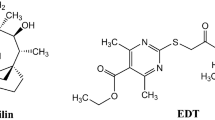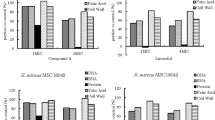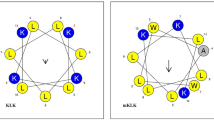Abstract
Novel muraminomicin derivatives with antimicrobial activity against methicillin-resistant Staphylococcus aureus (MRSA) were synthesized by esterification of the hydroxy group on the diazepanone ring of muraminomicin Z1. Compound 1b (DS14450354) possessed a diheptoxybenzyl-β-Alanyl-β-Alanyl group and exhibited minimum inhibitory concentrations (MICs) against MRSA comparable to those against methicillin-susceptible S. aureus (MSSA). The MICs that inhibited 50 and 90% of the strains were 1 and 2 μg/mL, respectively. Compound 1a (DS60182922) possessed an aminoethylbenzoyldodecylglycyl moiety and showed bactericidal activity against MSSA Smith. The bactericidal activity of 1a against MRSA 10925 was comparatively lower, whilst 1b exhibited dose-dependent bactericidal activity against MRSA 10925. The mutation frequency of 1b was lower than that of 1a. An amino acid substitution (F226I) was observed in MraY mutants isolated from culture plates containing 1a or 1b. Subcutaneous 1a and 1b administration showed good therapeutic efficacy in murine systemic infection models with MSSA Smith and MRSA 10925, comparable to that of vancomycin, suggesting that the novel muraminomicin derivatives may be effective therapeutic agents against MRSA that warrant further investigation. A scheme for the formulation of the key ester intermediate, requiring no HPLC preparation, was also established.
Similar content being viewed by others
Log in or create a free account to read this content
Gain free access to this article, as well as selected content from this journal and more on nature.com
or
References
Liu C. et al. Clinical practice guidelines by the Infectious Diseases Society of America for the treatment of methicillin-resistant Staphylococcus aureus infections in adults and children. Clin Infect Dis. 2011;52:e18–e55. https://doi.org/10.1093/cid/ciq146.
Lowy FD. Staphylococcus aureus infections. N Engl J Med. 1998;339:520–32.
Chien JW, Kucia ML, Salata RA. Use of linezolid, an oxazolidinone, in the treatment of multidrug-resistant gram-positive bacterial infections. Clin Infect Dis. 2000;30:146–51.
Arbeit RD. et al. The safety and efficacy of daptomycin for the treatment of complicated skin and skin-structure infections. Clin Infect Dis. 2004;38:1673–81.
Jorgenson MR, DePestel DD, Carver PL. Ceftaroline fosamil: a novel broad-spectrum cephalosporin with activity against methicillin-resistant Staphylococcus aureus. Ann Pharmacother. 2011;45:1384–98.
McGuinness WA, Malachowa N, DeLeo FR. Vancomycin resistance in Staphylococcus aureus. Yale J Biol Med. 2017;90:269–81.
Gómez CN, Siller RM, Muñoz BJL. Mechanisms of resistance to daptomycin in Staphylococcus aureus. Rev Esp Quimioter. 2017;30:391–96.
Musumeci R, et al. Resistance to linezolid in Staphylococcus spp. clinical isolates associated with ribosomal binding site modifications: novel mutation in domain V of 23S rRNA. New Microbiol. 2016;39:269–73.
Kimura K, Bugg TDH. Recent advances in antimicrobial nucleoside antibiotics targeting cell wall biosynthesis. Nat Prod Rep. 2003;20:252–73.
Boyle DS, Donachie WD. MraY is an essential gene for cell growth in Escherichia coli. J Bacteriol. 1998;180:6429–32.
Thanassi JA, Hartman-Neumann SL, Dougherty TJ, Dougherty BA, Pucci MJ. Identification of 113 conserved essential genes using a high-throughput gene disruption system in Streptococcus pneumoniae. Nucleic Acids Res. 2002;30:3152–62.
Takatsuki A, Arima K. Tamura G. Tunicamycin, a new antibiotic. I. Isolation and characterization of tunicamycin. J Antibiot. 1971;24:215–23.
Isono K, et al. Liposidomycins: novel nucleoside antibiotics which inhibit bacterial peptidoglycan synthesis. J Antibiot. 1985;38:1617–21.
Yamaguchi H, et al. Capuramycin, a new nucleoside antibiotic. Taxonomy, fermentation, isolation and characterization. J Antibiot. 1986;39:1047–53.
Inukai M, et al. Mureidomycins A-D, novel peptidylnucleoside antibiotics with spheroplast forming activity. I. Taxonomy, fermentation, isolation and physico-chemical properties. J Antibiot. 1989;42:662–6.
Karwowski JP, et al. Pacidamycins, a novel series of antibiotics with anti-Pseudomonas aeruginosa activity. I. Taxonomy of the producing organism and fermentation. J Antibiot. 1989;42:506–11.
Chatterjee S, et al. Napsamycins, new Pseudomonas active antibiotics of the mureidomycin family from Streptomyces sp. HIL Y-82,11372. J Antibiot. 1994;47:595–8.
McDonald LA, et al. Structures of the muraymycins, novel peptidoglycan biosynthesis inhibitors. J Am Chem Soc. 2002;124:10260–1.
Igarashi M, et al. Caprazamycin B, a novel anti-tuberculosis antibiotic, from Streptomyces sp. J Antibiot. 2003;56:580–3.
Murakami R, et al. A-102395, a new inhibitor of bacterial translocase I, produced by Amycolatopsis sp. SANK 60206. J Antibiot. 2007;60:690–5.
Murakami R, et al. A-94964, a novel inhibitor of bacterial translocase I, produced by Streptomyces sp. SANK 60404. I. Taxonomy, isolation and biological activity. J Antibiot. 2008;61:537–44.
Fujita Y, et al. A-90289 A and B, new inhibitors of bacterial translocase I, produced by Streptomyces sp. SANK 60405. J Antibiot. 2011;64:495–501.
Bugg TD, Lloyd AJ, Roper DI. Phospho-MurNAc-pentapeptide translocase (MraY) as a target for antibacterial agents and antibacterial proteins. Infect Disord Drug Targets. 2006;6:85–106.
Isono F, Katayama T, Inukai M, Haneishi T. Mureidomycins A-D, novel peptidylnucleoside antibiotics with spheroplast forming activity. III. Biological properties. J Antibiot. 1989;42:674–9.
Fujita Y, et al. Muraminomicins, new lipo-nucleoside antibiotics from Streptosporangium sp. SANK 60501-structure elucidations of muraminomicins and supply of the core component for derivatization. J Antibiot. 2019. https://doi.org/10.1038/s41429-019-0215-7
Dini C, et al. Synthesis of sub-micromolar inhibitors of MraY by exploring the region originally occupied by the diazepanone ring in the liposidomycin structure. Bioorg Med Chem Lett. 2002;12:1209–13.
Takeoka Y, et al. Expansion of antibacterial spectrum of muraymycins toward Pseudomonas aeruginosa. ACS Med Chem Lett. 2014;5:556–60.
Takahashi Y. et al. Novel semisynthetic antibiotics from caprazamycins A–G: caprazene derivatives and their antibacterial activity. J Antibiot. 2013;66:171–8.
Clinical and Laboratory Standards Institute. Methods for dilution antimicrobial susceptibility tests for bacteria that grow aerobically—9th ed.: Approved Standard M07-A9. Wayne, PA, USA: CLSI; 2012.
National Committee for Clinical Laboratory Standards. Methods for determining bactericidal activity of antimicrobial agents; approved guideline, NCCLS document M26-A. Wayne, PA, USA: NCCLS; 1999.
Acknowledgements
We thank Mr. Yoshikazu Nezu (Specialty Medicine Research Laboratory), Dr. Naoyuki Maeda (Biomarker & Translational Research Department) and Dr. Yasuyuki Abe (Specialty Medicine Research Laboratory) for the safety evaluation and Dr. Takahiro Shibayama (Clinical Pharmacology Department) for the PK analysis.
Author information
Authors and Affiliations
Corresponding author
Ethics declarations
Conflict of interest
The authors declare that they have no conflict of interest.
Additional information
Publisher’s note Springer Nature remains neutral with regard to jurisdictional claims in published maps and institutional affiliations.
Supplementary information
Rights and permissions
About this article
Cite this article
Kagoshima, Y., Tokumitsu, A., Masuda, T. et al. Muraminomicins, novel ester derivatives: in vitro and in vivo antistaphylococcal activity. J Antibiot 72, 956–969 (2019). https://doi.org/10.1038/s41429-019-0235-3
Received:
Revised:
Accepted:
Published:
Issue date:
DOI: https://doi.org/10.1038/s41429-019-0235-3



